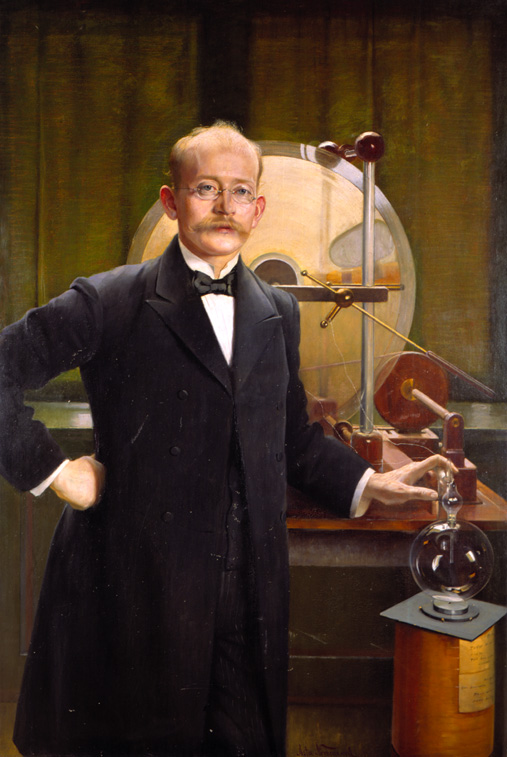Kristian Olaf Bernhard Birkeland (13 December 1867 – 15 June 1917) was a Norwegian scientist who has been called “the first space scientist”[1] and “the father of plasma experiments in the laboratory and space”[2] [3] [4]. He is perhaps most well-known for his scientific work on the aurora using a terrella (a magnetized globe), and as inventor of an electromagnetic cannon, and, a method of electrically producing artificial fertilizer. He also became a full professor of physics at the University of Oslo at the age of 31.
Birkeland also had astrophysical research published on cathode rays,[5] the Zodiacal lights,[6] comets,[7] the Sun and sunspots,[8] the origin of planets and their satellites,[9] the Earth’s magnetism.[10]
Some of Birkeland’s other contributions to science included:[2] • Derived the general expression for the Poynting vector • Gave the first general solution to Maxwell’s equations [11] • Pioneered the field of charged-particle beams • Utilized the concept of “longitudinal mass” • Constructed the first foil diodes • Pioneered the field of visible-light photography of electrical discharges • Advocated charged-particle propulsion engines for space travel • Created Norsk Hydro’s nitrogen-fertilizer industry (the Birkeland-Eyde method for production of potassium nitrate) • Invented an electromagnetic rail gun capable of firing a 10-kg projectile • Established Birkeland’s Firearms company • Anticipated cosmic rays (discovered in 1911) with his calculations involving energies of several billion electron volts • Held patents on the electromagnetic cannon,[12] electric blankets, solid margarine, and hearing aids.
In 1969 when field-align currents had been identified in the Earth’s atmosphere, they were named in his honor: Birkeland currents.[13]
Contents
Investigating the aurora
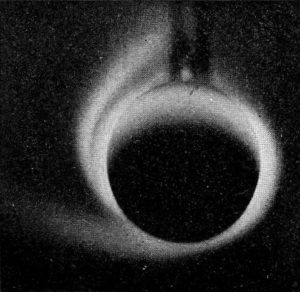
After encouragement from his maths teacher encouraged, Birkeland bought a bar magnetic, and read about William Gilbert’s (1544-1603) study of the Earth’s magnetism, and his terrella made from naturally magnetized lodestone. Gilbert surmised that the Earth was like a bar magnet whose magnetism was somehow related to electricity.
He organized several expeditions to Norway’s high-latitude regions where he established a network of observatories under the auroral regions to collect magnetic field data. The results of the Norwegian Polar Expedition conducted from 1899 to 1900 contained the first determination of the global pattern of electric currents in the polar region from ground magnetic field measurements. The discovery of X-rays inspired Birkeland to develop vacuum chambers to study the influence of magnets on cathode rays. An example of one of his experiments is depicted on the left front of the bank note. It shows a magnetized terrella, simulating the Earth, suspended in an evacuated box. Birkeland noticed that an electron beam directed toward the terrella was guided toward the magnetic poles and produced rings of light around the poles and concluded that the aurora could be produced in a similar way. He developed a theory in which energetic electrons were ejected from sunspots on the solar surface, directed to the Earth, and guided to the Earth’s polar regions by the geomagnetic field where they produced the visible aurora. Birkeland was nominated for the Nobel Prize no less than seven times.
Electromagnetic cannon
- See also: A. Egeland, “Birkeland’s electromagnetic gun: a historical review“, IEEE Transactions on Plasma Science, Apr 1989, Volume: 17, Issue: 2, page(s): 73-82, ISSN: 0093-3813. PEER REVIEWED
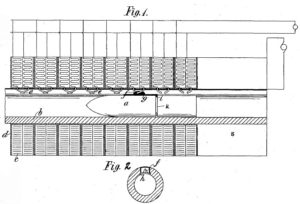
However, fate intervened in the form of an engineer named Sam Eyde.
At a dinner party only one week later, Eyde told Birkeland that there was an industrial need for the biggest flash of lightning that can be brought down to Earth in order to make artificial fertilizer. Birkeland’s climactic reply was: I have it! There were no more attempts to sell the firearms company, and he worked with Eyde only long enough to build a plasma arc device for the nitrogen fixation process. The pair worked to develop the prototype furnace into a design that was economically viable for large-scale manufacture. Birkeland then enjoyed adequate funding for his only real interest: research.
The fact that Birkeland joined with Eyde as a business partner, appears to have been one of the reasons why Birkeland was unsuccessful in being awarded the Nobel Prize for his idea. Eyde wanted to be nominated along with Birkeland, however the Nobel Prize is designed to recognise the original idea, not any commercial applications. This resulted in a possibly contentious nomination, and this combined with the fact that at that time relations between Sweden and Norway were delicate, meant that he wasn’t nominated by the committee.
Cosmic theories
In 1913, Birkeland may have been the first to predict that plasma was ubiquitous in space. He wrote: “It seems to be a natural consequence of our points of view to assume that the whole of space is filled with electrons and flying electric ions of all kinds. We have assumed that each stellar system in evolutions throws off electric corpuscles into space. It does not seem unreasonable therefore to think that the greater part of the material masses in the universe is found, not in the solar systems or nebulae, but in “empty” space. [15]
In 1916, Birkeland was probably the first person to successful predict that the solar wind behaves as do all charged particles in an electric field, “From a physical point of view it is most probable that these new solar rays are neither exclusively negative nor positive rays, but of both kinds”; in other words, the Solar Wind consists of both negative electrons and positive ions.[16]
Field-aligned “Birkeland” currents
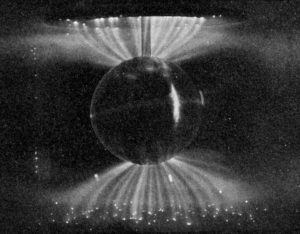
- See also: “On Possible Electric Phenomena in Solar Systems and Nebulae” by Kristian_Birkeland
Birkeland suggested that polar electric currents — today referred to as auroral electrojets — were connected to a system of currents that flowed along geomagnetic field lines into and away from the polar region. He provided a diagram of field-aligned currents in his book, “The Norwegian Aurora Polaris Expedition 1902-1903“. This diagram is reproduced on the back of the bank note in the lower right corner. This book contains chapters on magnetic storms on the Earth and their relationship to the Sun, the origin of the Sun itself, comets, and the rings of Saturn. Birkeland’s vision of field-aligned currents became the source of a controversy that continued for a quarter of a century, because their existence could not be confirmed from ground-based measurements alone.
The absolute proof of Birkeland’s field-aligned currents could only come from observations made above the ionosphere with satellites. A magnetometer onboard a U.S. Navy navigation satellite launched in 1963 observed magnetic disturbances on nearly every pass over the high-latitude regions of the Earth.
The magnetic disturbances were originally interpreted as hydromagnetic waves, but it was soon realized that they were due to field-aligned or Birkeland currents. The first complete map of the statistical location of Birkeland currents in the Earth’s polar region was developed in 1974 by A.J. Zmuda and J.C. Armstrong and refined in 1976 by T. Iijima and T.A. Potemra from satellite-borne magnetic field observations.
The ring encircling the magnetic pole depicted on the back of the bank note is similar to the patterns of Birkeland and current derived from satellites. Birkeland’s face appears a second time in a watermark in the blank space above the drawing of the Terrella, and his rudimentary magnetosphere appears on the back but is only visible under ultraviolet light.
Personal life
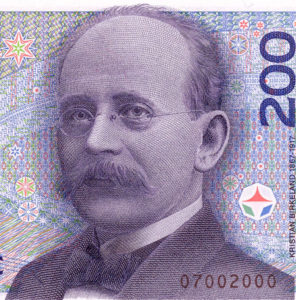
Kristian Birkeland was born on 13 December 1867 in Christiania (now called Oslo) in Norway, to Reinert Tønnesen Birkeland (1838–1899) and his wife Ingeborg Susanne Ege 1841-1913). He also had an older brother called Tønnes, [17] and one of his cousins, Richard Birkeland (1879–1928) became a professor of Applied Mathematics. His ancestors were farmers from a district called Birkeland in southern Norway.
Finishing school in 1885, Birkeland entered the University of Oslo studying chemistry and mathematics for two year, then switching to theoretical physics before graduating in 1890 with a Candidatus Realium degree. Two years later, he became a full-time research assistant, and was offered a scholarship, so he decide to travel abroad where he studied with French physicist Henri Poincaré, and Swiss physicists Lucien De La Rive, and Edouard Sarasin, investigating the energy transfer of electromagnetic waves.[4]
Kristian married fairly late in life (aged 37) to Ida Charlotte Hammer in May 1905. They had no children, and due to Kristian’s work, their marriage eventually broke down, and in 1911, they divorced.[18]
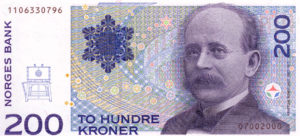
Quotes
- It seems to be a natural consequence of our points of view to assume that the whole of space is filled with electrons and flying electric ions of all kinds. — Kristian Birkeland
- A very few lonely pioneers make their way to high places never before visited . . . they create the living conditions of mankind and the majority are living on their work. — Kristian Birkeland
Footnotes
- ↑ *Kristian Birkeland, The First Space Scientist (2005) [ISBN 1-4020-3293-5] by Egeland, Alv, Burke, William J. PEER REVIEWED (Contents)
- ↑ 2.0 2.1 A. L. Peratt; C.-G. Fälthammar, N. Rynn, “Guest Editorial: Plasma Experiments in the Laboratory and in Space” IEEE Transactions on Plasma Science Vol. 20 No.6 (Dec 1992) PEER REVIEWED (full text) FULL TEXT PDF
- ↑ Kristian Birkeland, The Norwegian Aurora Polaris Expedition 1902-1903, Publ. H. Aschehoug & Co. Section 1 publ. 1908, Section 2 publ. 1913. Online in full FULL TEXT
- ↑ 4.0 4.1 A. Egeland, E. Leer, “Professor Kr. Birkeland: His Life and Work“, in IEEE Transactions on Plasma Science Vol 14 No. 6 Dec 1986, p. 666-677, ISSN: 0093-3813 PEER REVIEWED
- ↑ “Sur un spectre des rayons cathodiques” FULL TEXT (On a spectrum of the cathode rays;) (1896) Comptes rendus hebdomadaires des séance de I’Academie des sciences, T. 123, 492-495. PEER REVIEWED
- ↑ “Calcul des lignes d’intensités égales dans la lumière zodiacal” PEER REVIEWED (Calculation of the lines of equal intensities in the zodiacal light) (1914) Birkeland et Skolem, Comptes rendus hebdomadaires des séances de l’Académie des sciences, T. 159, 495-497. PEER REVIEWED
- ↑ The Norwegian Aurora Polaris Expedition 1902-1903 Part II, Chapter 5. Is It Possible To Explain Zodiacal Light, Comets’ Tails, And Saturn’s Ring By Means Of Corpuscular Rays? (1913) ACADEMIC BOOK Section 124. Comet Tails FULL TEXT
- ↑ “Le soleil et ses taches” FULL TEXT (The Sun and its spots). (1911) Comptes rendus hebdomadaires des séances de l’Académie des sciences, T. 153, 456-459. PEER REVIEWED
- ↑ “Sur l’origine de planètes et de leurs satellites” FULL TEXT (On the origin of planets and their satellites) (1912) Comptes rendus hebdomadaires des séances de l’Académie des sciences, T. 155, 892-895. PEER REVIEWED
- ↑ “Sur la conservation et l’origine du magnetisme terrestre” FULL TEXT (On the conservation and origin of terrestrial magnetism). Comptes rendus hebdomadaires des séances de I’Académie des sciences, T. 157, 275-277. PEER REVIEWED
- ↑ Kr. Birkeland, “Solution generale des equations de Maxwell pour un milieu absorbant homogene et isotrope” FULL TEXT Comptes Rendus (Paris), vol. CXXI, 1895. PEER REVIEWED
- ↑ US Patent number 754637 (1902) Electromagnetic Gun FULL TEXT
- ↑ * Schield, M. A.; Freeman, J. W.; Dessler, A. J., (1969) “A Source for Field-Aligned Currents at Auroral Latitudes“, Journal of Geophysical Research, Vol. 74, p.247. PEER REVIEWED
- ↑ “Electromagnetic Gun”, US Patent number 754637
- ↑ Kristian Birkeland, The Norwegian Aurora Polaris Expedition 1902-1903, Publ. H. Aschehoug & Co. Section 1 publ. 1908, Section 2 publ. 1913. Online in full FULL TEXT p.720
- ↑ Kristian Birkeland, “Are the Solar Corpuscular Rays that penetrate the Earth’s Atmosphere Negative or Positive Rays?” Videnskapsselskapets Skrifter, I Mat — Naturv. Klasse No.1, Christiania, 1916.
- ↑ Professor Alf Egeland, “Olav Christian Bernhard Birkeland“, Web site, Research group for Plasma and Space Physics, University of Oslo
- ↑ Lucy Jago, The Northern Lights: The True Story of the Man Who Unlocked the Secrets of the Aurora Borealis (2001) [ISBN 0-375-40980-7]
References
External links
- The NOK 200 note with Kristian Brikeland (Norwegian) (English)
- On Possible Electric Phenomena in Solar Systems and Nebulae, Extract from The Norwegian Aurora Polaris Expedition 1902-1903
- Kristian Olaf Bernhard Birkeland at The Norwegian Museum of Science and Technology
Books
- Kristian Birkeland, The Norwegian Aurora Polaris Expedition 1902-1903, Publ. H. Aschehoug & Co. Section 1 publ. 1908, Section 2 publ. 1913. Online in full FULL TEXT
- Kristian Birkeland, The First Space Scientist (2005) [ISBN 1-4020-3293-5] by Egeland, Alv, Burke, William J. PEER REVIEWED (Contents)
- The Northern Lights: The True Story of the Man Who Unlocked the Secrets of the Aurora Borealis (2001) [ISBN 0-375-40980-7] by Lucy Jago
Articles
- Kristian Birkeland bibliography
- Kristian Birkeland, 1867–1917 FULL TEXT, Monthly Weather Review, Article: pp. 300–300 (reprinted from Nature, London, June 31,1917, 99: 349.1) PEER REVIEWED
- The contributions of Kristian Birkeland to space physics (1997), Potemra, T. A., Geomagnetism and Aeronomy with Special Historical Case Studies. IAGA Newsletters 29/1997. Sponsored by the Interdivisional Commission on History IAGA, and the Historical Commission on History of the German Geophysical Society. Edited by Wilfried Schröder. ISSN 0179-5658. Published by IAGA, Germany, 1997, p.107 PEER REVIEWED
- Birkeland, Kristian (1868-1917) (2001) Murdin, P. in Encyclopedia of Astronomy and Astrophysics, Edited by Paul Murdin, article 5443
- J. A. Harker, “Solar Electrical Phenomena“, Nature 92, 131-132 (02 October 1913)
- More articles from the NASA Astrophysics Data System
- Sydney Borowitz, “The Norwegian and the Englishman“, Physics in Perspective, Volume 10, Issue 3, pp.287-294 PEER REVIEWED
- A. Egeland, E. Leer, “Professor Kr. Birkeland: His Life and Work“, in IEEE Transactions on Plasma Science Vol 14 No. 6 Dec 1986, p. 666-677, ISSN: 0093-3813 PEER REVIEWED
- A. Egeland, “Kristian Birkeland – The man and the scientist“, in Magnetospheric currents Chapman Conference, Irvington, VA; United States; 5-8 Apr. 1983. pp. 1-16. 1984
- A. Egeland, “Birkeland’s electromagnetic gun: a historical review“, IEEE Transactions on Plasma Science, Apr 1989, Volume: 17, Issue: 2, page(s): 73-82, ISSN: 0093-3813. PEER REVIEWED
- Witkowski Nicolas, “Kristian Birkeland, prophète électromagnétique” (Kristian Birkeland, the prophet of electromagnetism), Recherche N°345 – Septembre 2001, ISSN 0029-5671
- Witkowski Nicolas, “Kristian Birkeland, fabricant d’aurores boréales” (Un physicien norvégien reproduit en laboratoire les effets du vent solaire), Sommaire, Hors série n°15 – Soleil
- Northern Lights by Lucy Jago, reviewed by David Smith in Physics Education, May 2002, p.269 FULL TEXT
- “1905: Three remarkable men (Kristian Birkeland, Sam Eyde and Marcus Wallenberg)“, Norsk Hydro ASA Web site
- Roger Smith, “The quest for the Northern Lights” (review of The Northern Lights by Lucy Jago) at physicsworld.com Sep 1, 2001 FULL TEXT
- “A New Electric Gun” (Prof. Birkeland’s Invention May Be Able to Throw Two Tons Ninety Miles), New York Times, May 8, 1902
- “Pictures Universe Electrified Space” (Prof. Birkeland of Norway Holds That Suns and Stars Are Charged Negatively), New York Times, February 23, 1913,
- “Electro-Magnetic Cannon]”, New York Times February 28, 1902 (81 words)
- Peratt, Anthony L., “Birkeland and the Electromagnetic Cosmology“, Sky and Telescope, volume 69, page 389. (full text) FULL TEXT
- Potemra, T. A.; Dessler, A. J., “Space scientist honored on Norwegian currency” (1995) Eos, Transactions American Geophysical Union, Volume 76, Issue 17, p. 174-174 PEER REVIEWED (Full text) FULL TEXT
Other Articles
- C. Chree, “Kristian Birkeland 1867–1917”, Monthly Weather Review, June 1917, Volume 45 Issue 6, p.300 (ref)
- “Birkeland’s Theory of the Zodiacal Light”, Monthly Weather Review, April 1914, Volume 42 Issue 4 , pp.209–211. (ref)
- John A. Anderson, Ph. D., “The Work of Prof. Carl Störmer on Birkeland’s Theory of the Aurora Borealis”, Monthly Weather Review, May 1908, Volume 36 Issue 5, pp.129–131 (ref)
- “Biographical sketch of Kr. Birkeland”, Terrestrial Magnetism and Atmospheric Electricity, Volume 14, Issue 2, pages 84–84a, June 1909 (ref)
Patents
- 1902, US Patent number 754637, Electromagnetic Gun FULL TEXT
- 1902, US Patent number 772862, Apparatus for Electrically Treating Gases FULL TEXT
- 1902, US Patent number 775123, Apparatus for Electrically Treating Gases FULL TEXT
- 1904, US Patent number 802620, Method of Treating Solid Materials FULL TEXT
- 1904, US Patent number 837277, Electric Furnace FULL TEXT
- 1904, US Patent number 889431, Furnace for Metallurgical and Smelting Purposes FULL TEXT
- 1907, US Patent number 906682, Electric Furnace FULL TEXT
- 1910, US Patent number 1011018, Furnaces FULL TEXT
- 1912, US Patent number 1236662, Manufacture of Concentrated Nitric Acid FULL TEXT
- 1912, US Patent number 1121606, Process of Treating Sulfid Ores and Other Metallic Sulfides FULL TEXT PDF
- 1913, US Patent number 1125259, Process of Hardening Oils FULL TEXT
